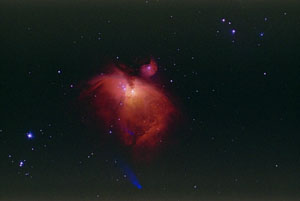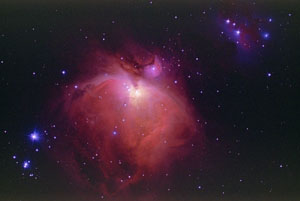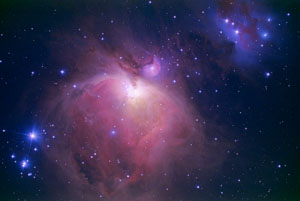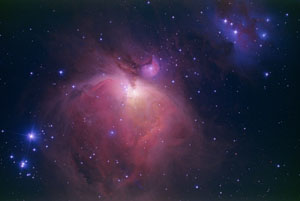 Picture 1
Picture 1
+
 Picture 2
Picture 2
+
 Picture 3
Picture 3
=
 Sum of 1, 2, 3
Sum of 1, 2, 3
In a computer lots of those tasks can be simplified and the whole process
becomes much easier. Now what is the idea behind stacking negatives?
First a weakly exposed negative cannot be printed conventionally without
loss in contrast. Stacking several negatives allows for much higher color
saturation.
Second film grain or general the noise of the image is reduced. The
signal noise ratio is increased with the square root of the number of stacked
images.
Third the exposure range of film or other detectors can be increased.
Areas that are over saturated in a long exposure might be visible in shorter
exposures. Thus combining short and longer exposures yield an increased
dynamic range.
Some of these ideas were tested in the following sequence. Three exposures of the orion nebula (1 min 5 min and 60 min) were transferred to PhotoCD and then processed. First a set of stars that were nicely spread over the pictures was identified in all three photos. From that set the transformation matrix (displacement, rotation and stretch) was computed. With the matrix elements it is easy to write a little program that precisely stacks two pictures and saves the added picture to disk. More pictures can be added to the sum to create an arbitrary number of pictures in the stack. All pictures were adjusted in brightness to use the available dynamic range to full extend. The pictures were added with 25% 25% and 50% weight with 50% for the longest exposure. Then the gamma for the pictures was increased to 1.7. The result is shown in the following sequence
 Picture 1
Picture 1
+
 Picture 2
Picture 2
+
 Picture 3
Picture 3
=
 Sum of 1, 2, 3
Sum of 1, 2, 3
Gamma =1.7
Stacking result Image 3 with Gamma =1.7
(Click on images to get 800x500 pixel version)
We see that both images are very similar. It is very difficult even in the enlarged versions to see the improvements. One has to look at very small detail to see the difference. The question is why? Surprisingly the answer is because it was done in a computer. Many of the results that are normally achieved in the darkroom only when stacking negatives can be accomplished in a computer with a single image.
The stretch of contrast and adjustment of color saturation can easily
be done in the computer.
The reduction of noise is not really noticeable in a small number of
stacked images. Remember it is proportional to the square root of the number
of images. At two images it is barely a factor of 1.4 which is not really
visible.
The problem of exposure saturation doesn't really happen with deep
sky objects. Most pictures there are weakly exposed anyway.
So with the help of the computer most of the work achieved in stacking negatives can be accomplished in a result from a single original.